Welcome to the 2022 edition of Quill & Pad’s early Grand Prix d’Horlogerie de Genève predictions in which the team picks favorites and explains why.
The panelists are:
Elizabeth Doerr (ED), co-founder and editor-in-chief
Ian Skellern (IS), co-founder and technical director
Joshua Munchow (JM), resident nerd writer
GaryG (GG), resident collector
Martin Green (MG), resident gentleman
This year (2022) is the first in a long time, if not ever, that mechanical clocks have had their own category in the GPHG, and it is long-awaited and warmly welcomed. Last year (2021) in particular had sensational clocks entered that were well-deserving of prizes.
This category is for mechanical time-measuring instruments like long-case and table clocks. Wristwatches are not allowed in this category.
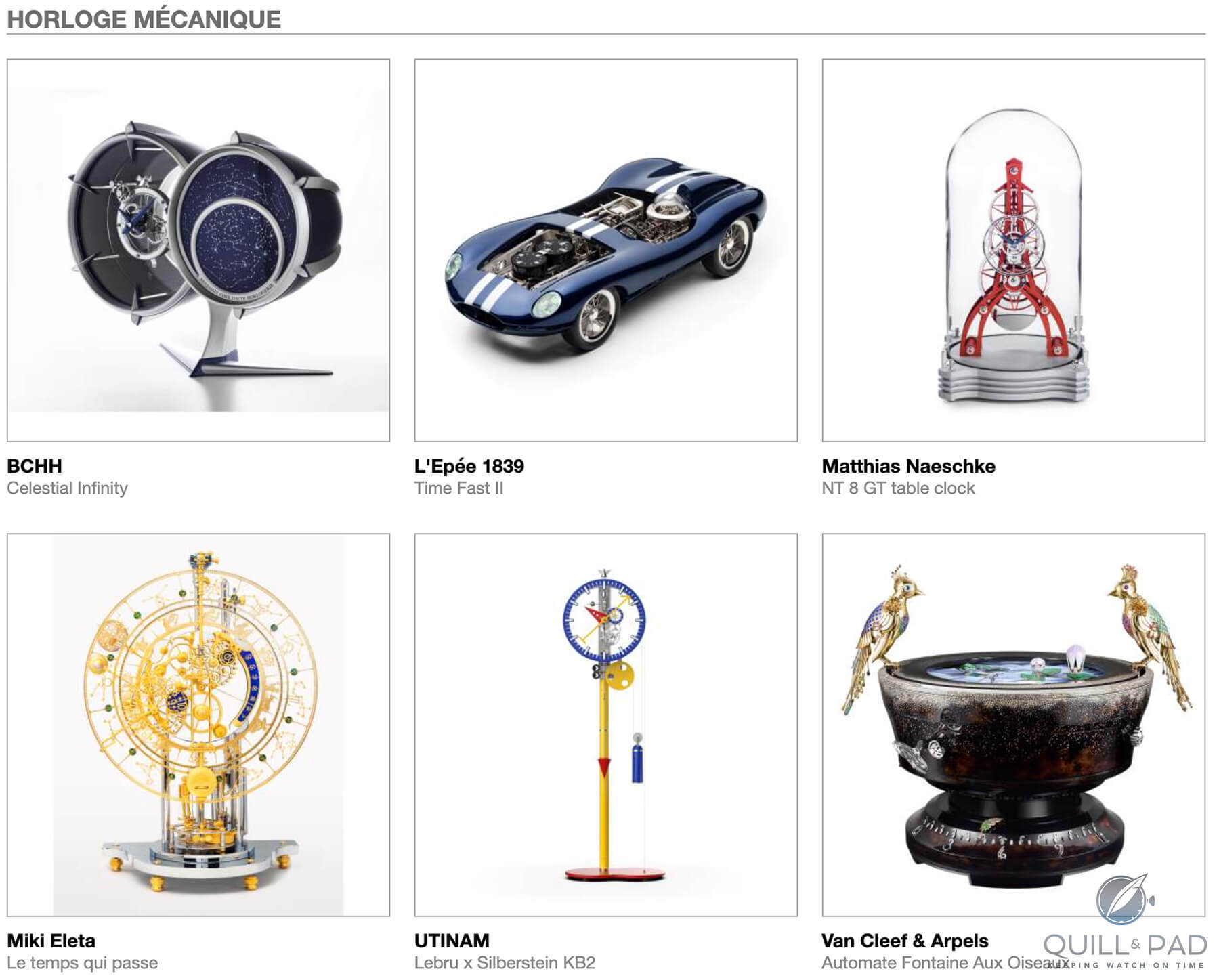
2022 GPHG Mechanical Clocks shortlist
IS: In every other GPHG category, including those deliberately rewarding the audacious, the majority, if not the vast majority, of watches featured look like traditional watches, i.e., the type of watch a (pre-digital-age) child might draw with central hands inside a round dial and case. But in this new (thank you for listening, GPHG committee) Mechanical Clock category, not one of the six finalists look anything like a traditional clock.
While at their hearts each is a traditional clock, the way each has been executed offers incredible diversity. I’d be very happy to have any of these clocks in my home and because they are all so different, I think I’d easily find a place for them all.
JM: Finally! After years of discussion that clocks should have a place and some instances of clocks being included in categories that made little sense in 2021, the GPHG has created a category for mechanical clocks. And, boy, what a complete smorgasbord of mechanical ingenuity!
When I saw that the category had been created and we could finally discuss the merits of incredible clocks I was excited. Now that I am comparing them side by side, I have the same feeling as with the Mechanical Exception category . . . this is going to be hard. Since it is such a broad and open category, the six entries are examples of six very different styles of design and mechanics, all of them awesome, but tricky to compare. I am possibly the least sure of the outcome of this category.
GG: After reviewing the finalists in this category in detail, I’m perilously close to giving up watch collecting in favor of clocks!
ED: I struggle with that a bit anyway, Gary. Clocks are amazing additions to any home!
MG: I find it very important that GPHG also has a category that rewards one of the ancient ways of telling time. What I like is that in this category there is still a lot of progression technically, but also aesthetically.
BCHH Celestial Infinity
JM: If you want a clock that would look perfectly at home on the bridge of a starship as it would on the bridge of a mega yacht, look no further than the Celestial Infinity. While it doesn’t specifically have a navigation-worthy star map, the complication on the right pod provides a stunning display of the changing night sky.
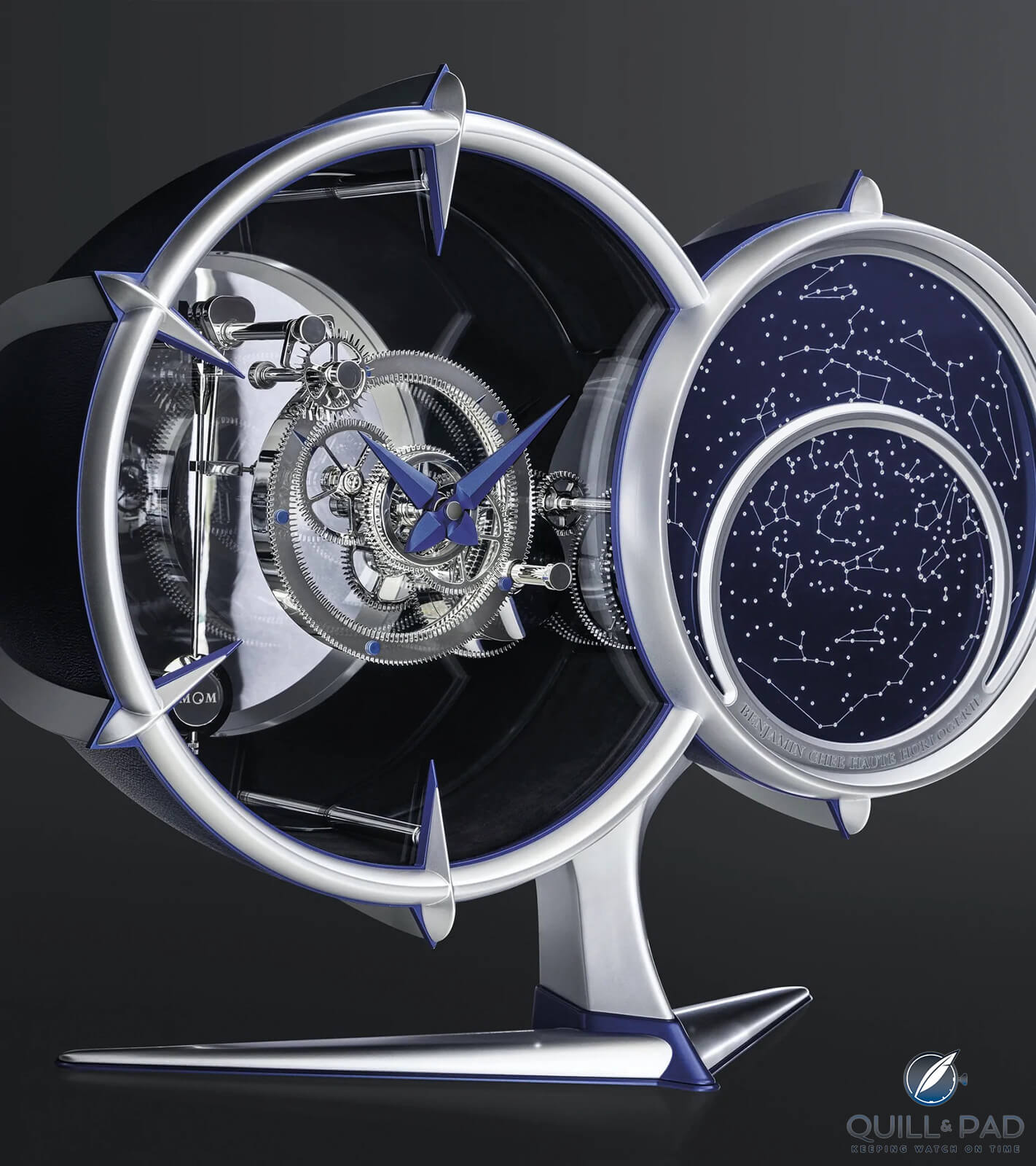
BCHH Celestial Infinity
For the movement, the hours are driven in an atypical way using a planetary gear system that relies on two superimposed gears of one tooth difference that allows the system to drive the minute hand one revolution per hour while the hour hand slowly crawls forward, demonstrating an interesting mechanical to the astute viewers. The twin pod styling of the clock is amazing and could keep you staring for days (since it has a 10-day movement), and this is the clock that strikes my sense of design the most. But given the other clocks in the category, it might not have enough mechanics to take the crown, so I have it tied with L’Epée as my second runner up.
MG: This is a clock that you might expect to find in the cabin of Captain Jean-Luc Picard of the USS Enterprise, Joshua! The astronomical complication is brought in a very captivating way, but the clock itself can rival the attention. That is quite an accomplishment. Even more, the clock features technical delicacies such as a Graham deadbeat escapement, superb finishing, and diamonds making up the stars in the sky. A true gem of a clock!
IS: The BCHH Celestial Infinity looks like something MB&F might have come out with, and I say that with high praise. I love the design, the mystery clock, and the separate astronomical indication. That astronomical dial (which is claimed to be the largest-diameter astronomical clock dial in the world) is not made of aventurine, those sparkles are diamonds! Plus, there’s a Graham escapement.
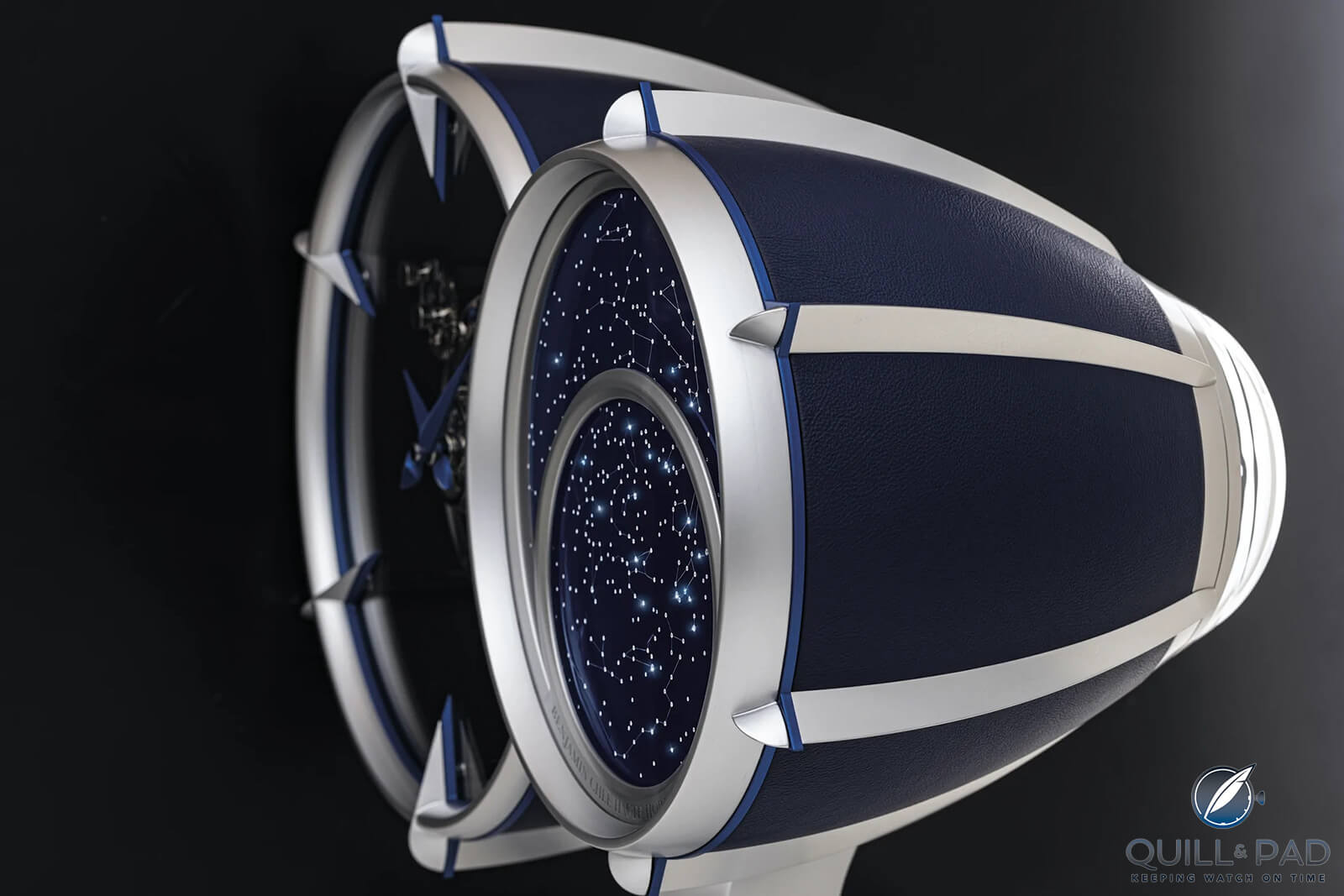
BCHH Celestial Infinity
And when I read in the description (paraphrased for brevity) that one of the interesting features is its gear train, which features epicyclic planetary gearing, and that the motion work is based on the Ferguson Mechanical Paradox that avoids the need for a 12:1 ratio gear train between the hour hand and the minute hand, my heart started beating even though I had no idea what the Ferguson Mechanical Paradox was. BCHH Celestial Infinity well deserves to win here, and I think the superb horology in this clock will be appreciated by this watchmaker-rich jury. But its avant-garde form, its main strength, is likely to be polarizing and I think that will count against it.
ED: Yes, I agree that the form will be quite polarizing for the jury, which is a real shame. This is a true gem of a clock.
GG: I love astronomic complications, so you might expect that the BCHH Celestial Infinity would appeal to me. The large-scale display of time with a mystery clock look is great, and the immense diamond-studded display of the night sky would look splendid on any side table in the world.
Quick Facts BCHH Celestial Infinity
Case: 680 x 575 mm, wood, leather, alcantara, aluminum
Movement: pendulum-powered movement by Alessandro Rigotto with planetary gearing, Graham escapement, and Invar pendulum; 10-day power reserve; 8,180 vph frequency
Functions: hours, minutes; rotating sky chart set with 8.03 cts of diamonds as stars and constellations
Limitation: 5 pieces
Price: CHF 148,800
L’Epée 1839 Time Fast II
GG: The L’Epée 1839 Time Fast II is so much fun I can’t stand it, with time displays as air filters on the carburetor covers, the escapement in the “driver’s helmet,” and two separate drive trains that power the time train and motor, with winding modes governed by a user-operated gear shift lever and the automation of the engine initiated by turning a dashboard key. Winding is achieved just as with the spring-driven toy cars of my youth, by pulling the car backwards on a flat surface.
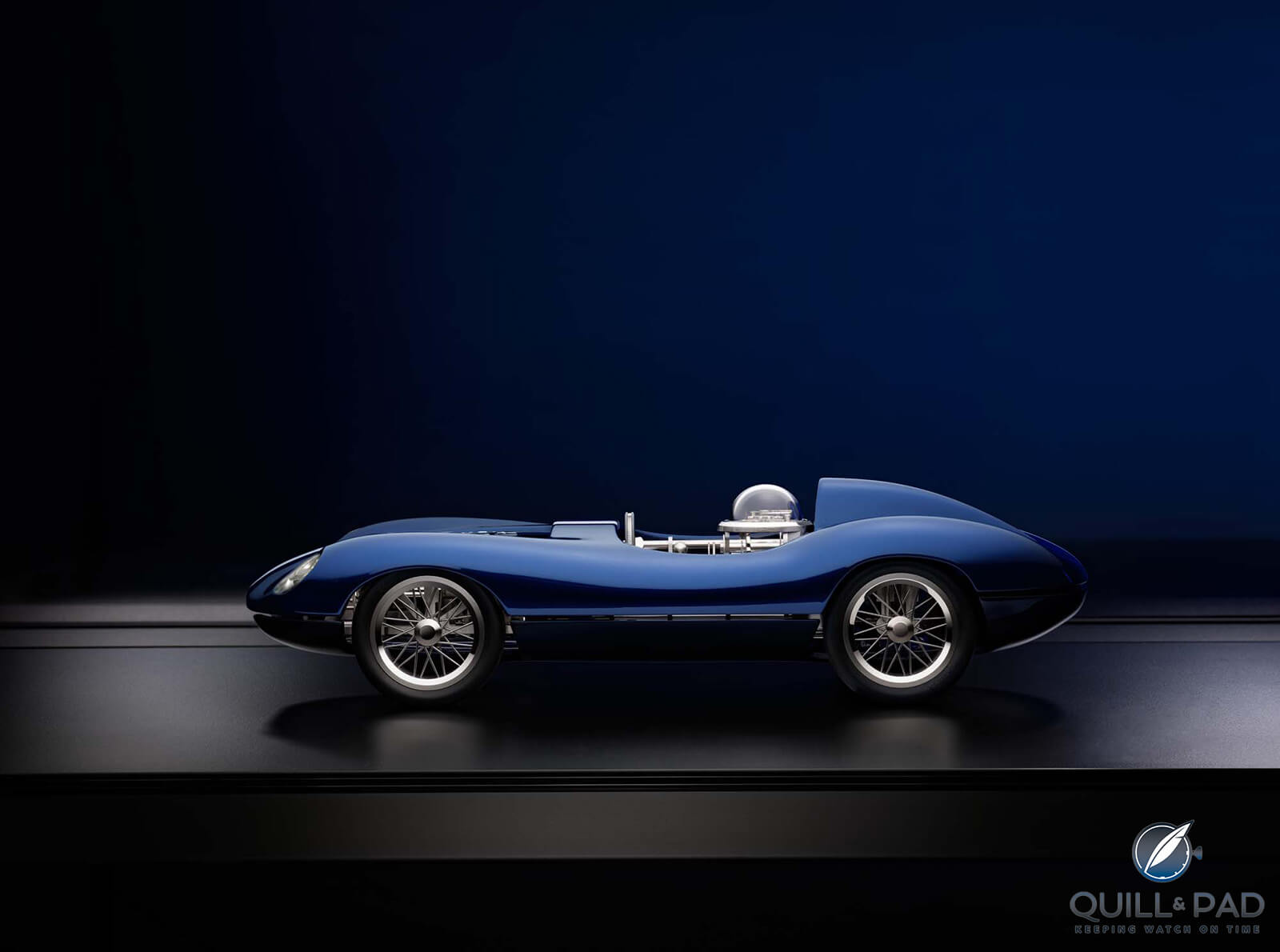
L’Epée 1839 Time Fast II
MG: This is actually my favorite clock that L’Epee has made so far. As a petrol head with a need for speed it is right up my alley, and as always is the execution of L’Epee is perfect. They have a knack for making complex clocks look so easy, and they also achieved that with this one. I also like how they integrated certain features of the car in the movement or is it the other way around?
ED: I love how this clock with its two movements (one for time keeping and one for the car’s V8 engine automaton) is “trapped” in the body of what looks and acts like a toy car! Appearances are so deceiving here: what looks and acts quite simple was indeed very hard to make. A great clock for the child inside all of us!
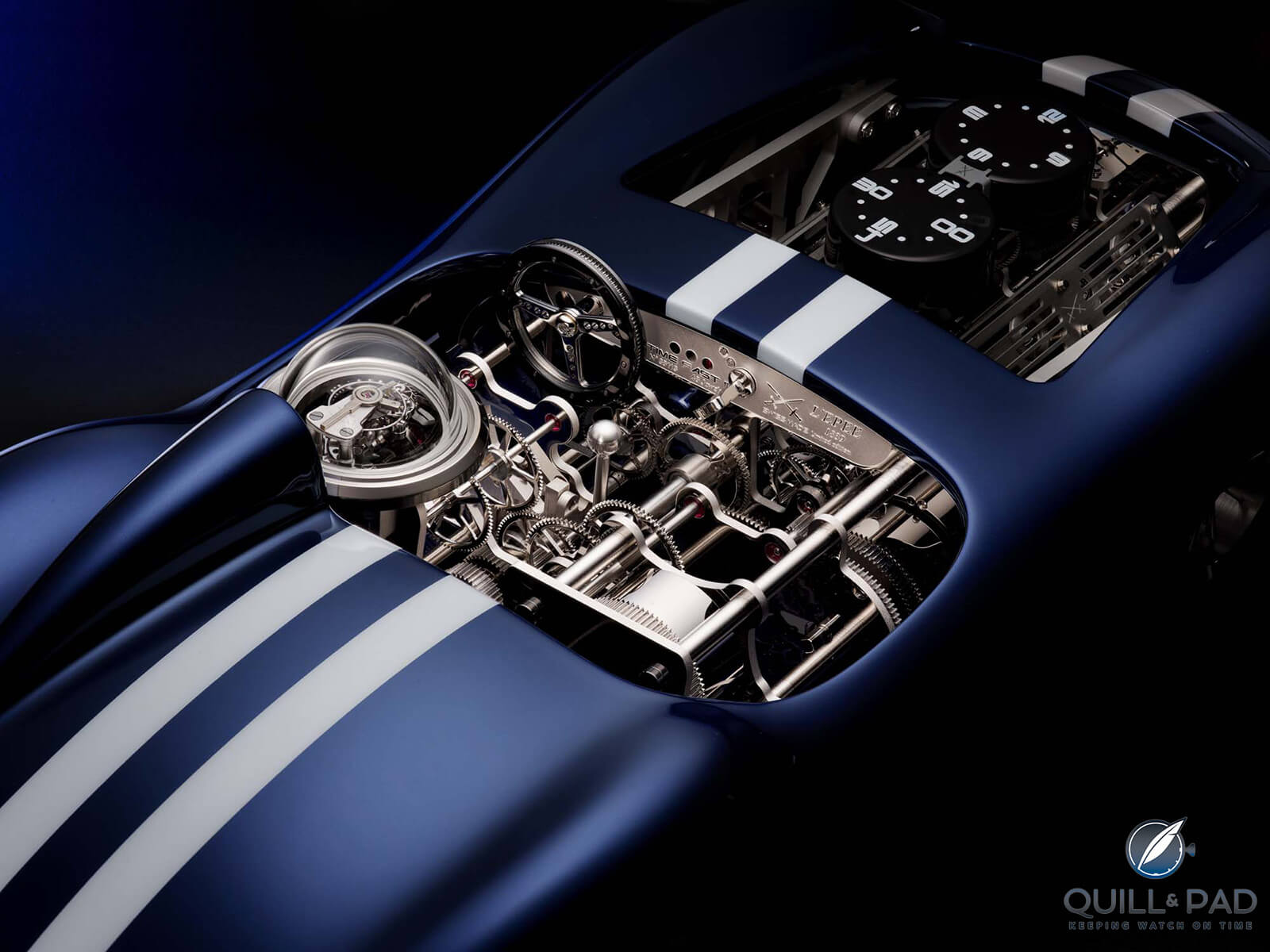
L’Epée 1839 Time Fast II cockpit
IS: I’ve had the opportunity to handle the L’Epée 1839 Time Fast II and my first thought was just how solid and well made it was. It weighs an impressive 4.7 kg (10.4 lbs), and in one of the many intriguing details in this clock, the rubber compound of the tires was carefully chosen so that the bottoms of the tires are slightly squashed, just like a real car. Time Fast II’s gear lever selects between winding (by rolling the car backwards) the clock mechanism and winding the V8 engine animation, and, intuitively, turning the key starts the engine. Then there’s the fact that the wheels and the steering wheel (the detailing iS incredible) are crafted just like their real counterparts
The attention to detail in Time Fast II is incredible, but despite the high-quality horology inside I think the fact that it looks like a toy car (its strength) rather than a clock will count against it here.
JM: L’Epée is always known for doing awesomely thematic clocks, whether it be a collaboration with a brand like MB&F, or if it is for a L’Epée exclusive model. The Time Fast II is such a cool and detailed model of an old race car that just so happens to have two mechanical movements underneath the body work. Sporting a movement that drives an automaton of the running engine besides the time display as well as the main mechanical movement mounted in the cockpit driving the hours and minutes in the engine bay, the Time Fast II has enough going on visually to excite any clock nerd. For those who want a little more, you have the ridiculously awesome interactions that take the clock over the top.
To wind the separate mainsprings, there is a gear lever in the cockpit that resembles a shift knob, pulling this knob in either direction switches between winding the time display or automaton, or remaining in neutral in the center. Winding is accomplished by putting the car on a desk or table and pulling it backwards, just like the wind-up toys we played with as kids. To set the time, a fully rotational steering wheel allows you to turn the dials when rotating clockwise and return the wheel to center rotating counterclockwise. There is also a small key in the dash that when turned appropriately starts the automaton of the running engine. As a mechanical artifact, it is such a unique item and could easily have won the competition if it weren’t for a couple of the other competing clocks. For that reason, I am relegating it to a tie for third place as a second runner up with BCHH.
Quick Facts L’Epée 1839 Time Fast II
Case: 189 x 450 x 120 mm, anodized aluminum
Movement: manual winding L’Epée 1839 1855 MHD in-house caliber with 8-day power reserve, 18,000 vph/2.5 Hz frequency
Functions: hours, minutes; power reserve, automaton
Limitation: 99 pieces
Price: CHF 40,000
Matthias Naeschke NT 8 GT
IS: Where the L’Epée 1839 Time Fast II impressed with its solid substance, Matthias Naeschke goes in the completely opposite direction of ethereal lightness with his NT 8 GT Table Clock. I love these open three-wheel clocks as you can see how they work, and they don’t come more open than the NT 8 GT. The gearing is all openworked, as is the Eiffel Tower-like frame acting as the main plate. And the glass dome base is in aluminum. The complete clock, including pendulum, comes in at just 1.5 kg (3.3 lbs). The NT 8 GT is a work of art, and at 22,500 Swiss francs it’s an incredible value for money compared with many high-end watches. I don’t think the NT 8 GT will win, but it well deserves its place here (and on my desk).
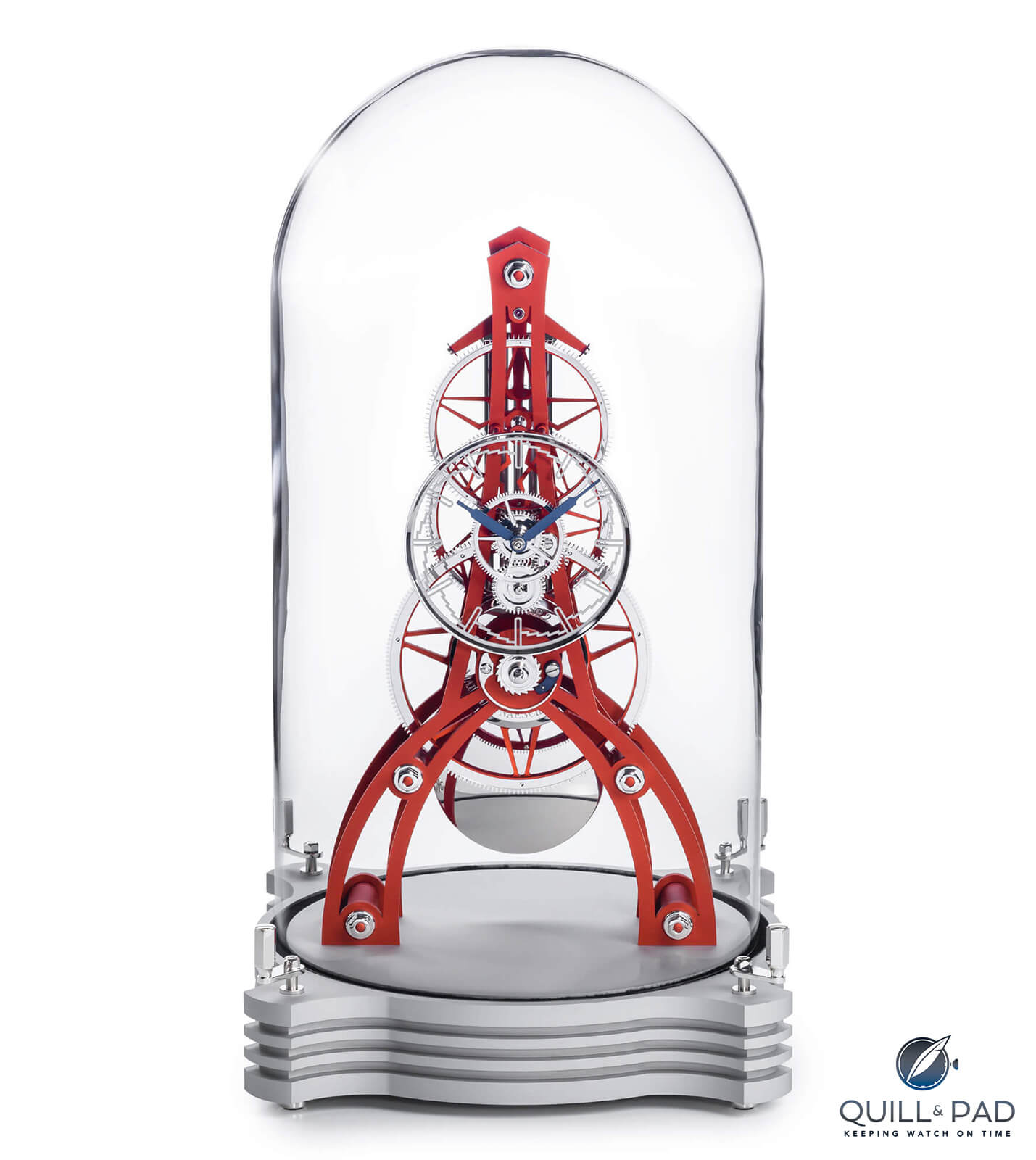
Matthias Naeschke NT 8 GT table clock
MG: I love the purity of this design and how it serves up the essence of a mechanical clock, yet with a contemporary twist, resulting in a striking table clock. I also like that it can be customized upon the client’s wishes as clocks tend to be very personal and quite a presence in a room.
GG: Matthias Naeschke’s NT 8 GT Table Clock is a lightweight marvel with its openworked plates and filigreed gears. It’s among the least complex of this year’s finalists mechanically, but a real accomplishment of skeletonization and I think it would look great as a counterpoint to the traditional Atmos clock I have ticking away in my office.
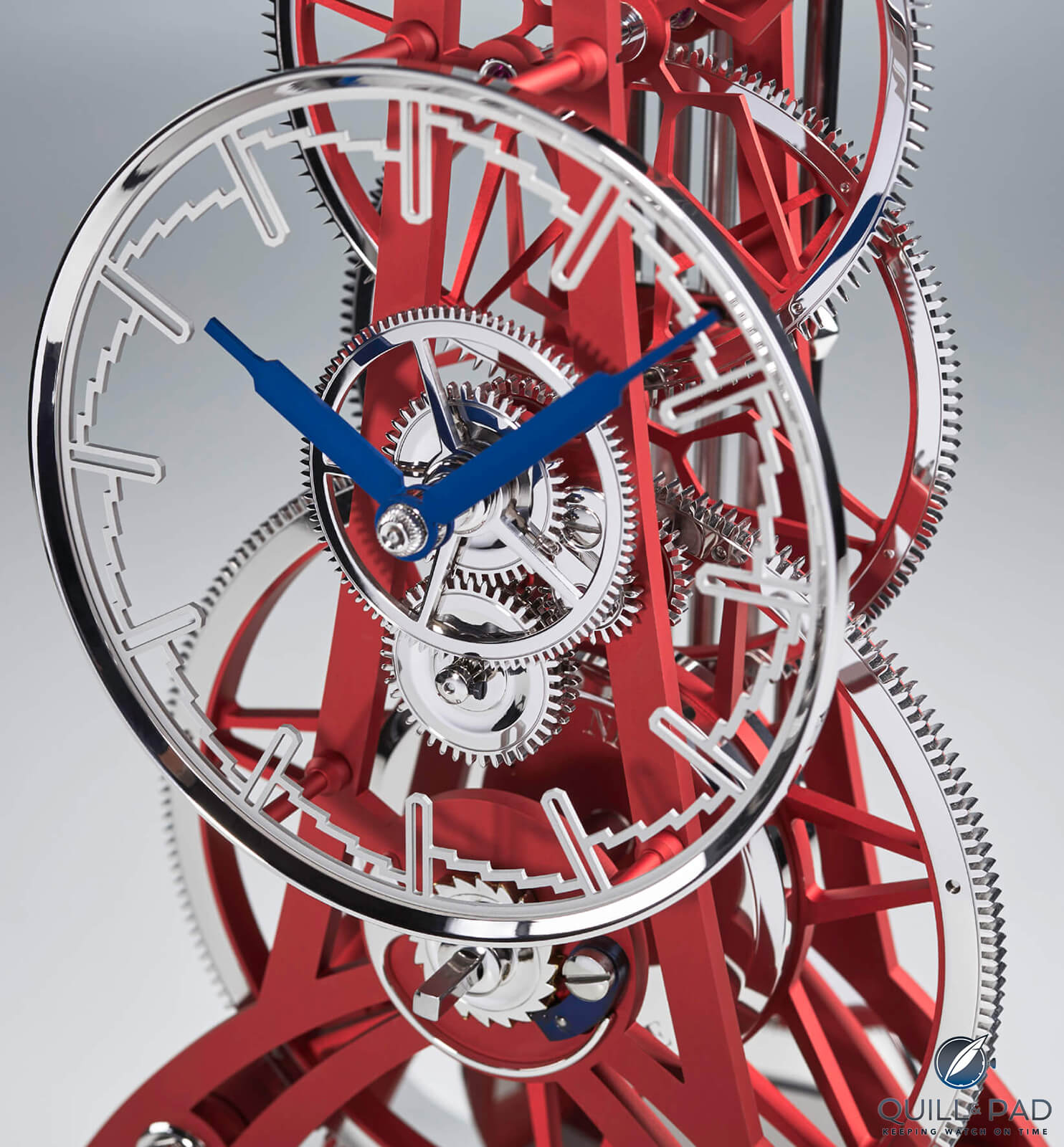
Matthias Naeschke NT 8 GT table clock details up close
JM: This is by far the most classic and “simple” of all the clocks within the category, which to many (I’m guessing) will almost immediately take this piece out of the running. It is an awesome modern mantel clock in the classic construction though the frame, wheels, and case are all skeletonized for extreme lightness. This is appreciable in a wristwatch you will be wearing, as a mantel clock I am less concerned if it weighs the specified 1.5 kilos or something much heftier. The design will probably be broadly popular, but without different categories for complications, astronomical clocks, or automatons, the NT 8 GT just feels overwhelmed by others in the group. I would love to have a version on my mantel, but it wouldn’t be my top choice from the group to win.
ED: I love how this independent clockmaker from southern Germany has managed to successfully make the jump from classic to modern clocks without missing a beat, and the NT 8 GT is a shining example. I think it will be hard for this beautifully simple timepiece to compete with a couple others for the crown in this category, but I hope that making the final six has brought the family-owned manufacture more of the recognition it deserves.
Quick Facts Matthias Naeschke NT 8 GT
Case: 280 x 280 x 500 mm, aluminum and glass
Movement: manual-winding caliber, 7,200 vph frequency, 170-hour power reserve
Functions: hours, minutes
Price: CHF 22,500
Miki Eleta The Passage of Time
GG: Miki Eleta gives us another masterpiece this year with his Passage of Time. I had to watch the video several times to understand the various astronomic and retrograde complications as well as the automaton of a human figure checking out the time on his wristwatch. As timekeeping for me is very much about mindfulness of the passage of time and our small place in a large universe, Eleta’s theme “Man is ephemeral, time is infinite” for this piece is absolutely on point for me.
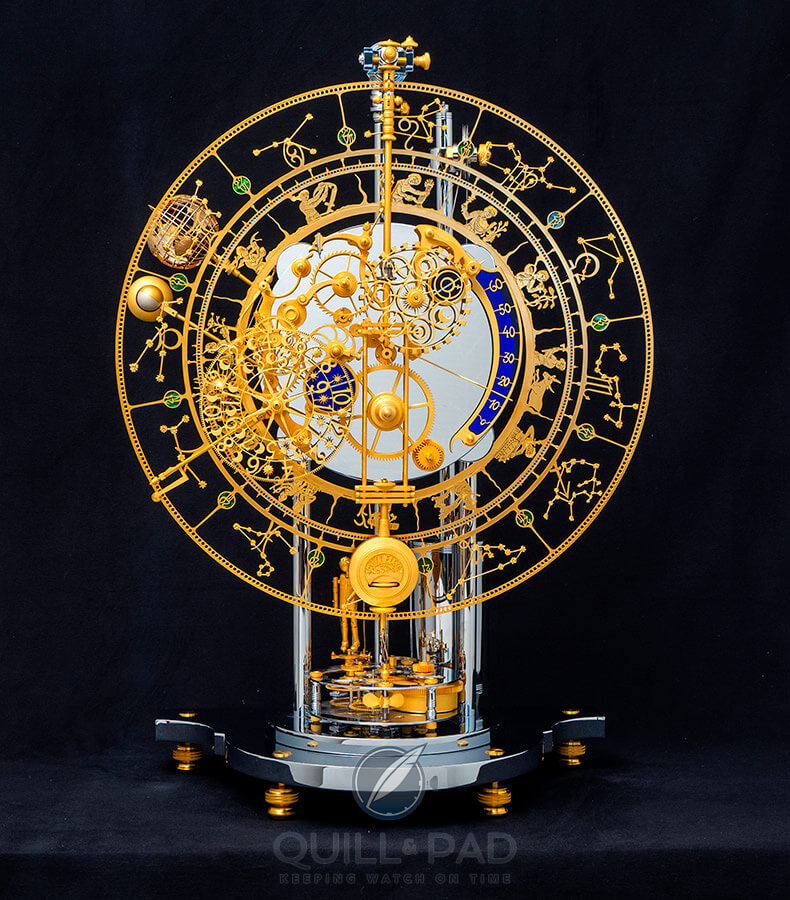
MG: Did somebody already knight Miki Eleta, because if they haven’t they should. His creations are always so unique and so complex that they can’t be compared to anything else. This one is just like it, and what is most mesmerizing to me is how he can put such complexity together with barely a visible movement. It seems like it is just not possible, yet he does make it happen. My runner up in this category.
IS: I think that Miki Eleta should have won either the Mechanical Exception or Aiguille d’Or at the 2021 GPHG for his Svemir clock, and here’s my (and hopefully the GPHG jury’s) chance to put that right. Eleta has never made a clock to date that hasn’t been a work of art both visually and horologically. Indications? Well since you ask, The Passage of Time displays (take a deep breath) include hours, retrograde minutes, date, day, month, year, moon phase, power reserve, worldtime, an automaton, day/night, and position of the sun. Plus, there’s Miki’s own Eleta Escapement.
The Miki Eleta The Passage of Time is my pick to win the Clock category, and I think it even has a good shot at taking the Aiguille d’Or.
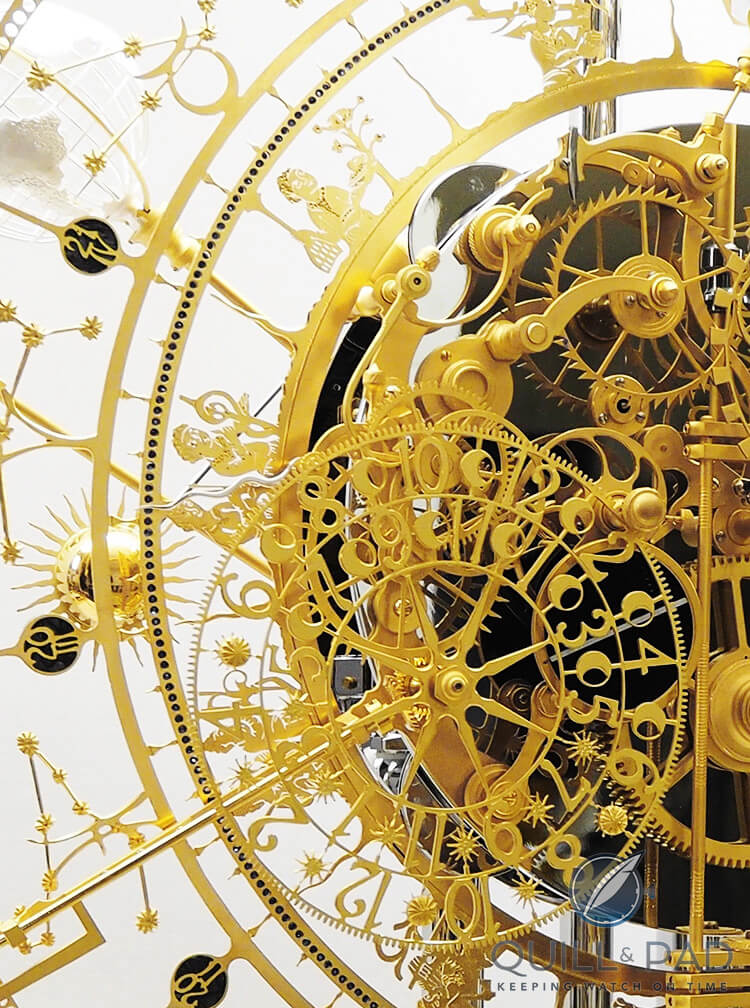
JM: This is a very hard call to make because this piece is just ridiculously incredible, entirely handmade by the inimitable Miki Eleta. It contains 11 complications, 13 total indications including a little automaton figure that checks the time on his wrist every 20 seconds. The display is a radiant explosion of mechanics, a sculpture of delicate gears, levers, springs, and supporting frames, all carefully crafted, finished, and gilded to provide a career defining creation. Yet for Eleta, it is just Table clock, No. 37. This is what makes this so incredible, it was a labor of love and expertise but far from a once in a lifetime achievement and instead a continuation of decades of exemplary work.
I love the work that went into it and the mechanical outcome of the clock itself. The only reason that I have it as my first runner-up and not the winner of the category is that it is a bit visually hard to read and the style is definitely not as broadly appealing as it could be. Does that mean it is any less awesome? No, but we are predicting winners and it makes me think that the jury might lean a different way. The sheer amount of handwork could take this piece to the winner’s circle, but I’m placing my bet on a different horse.
ED: It pains me not to name this clock my winner in this category, and I hope that Miki is not disheartened and will continue to enter his amazing work into the GPHG for years to come. A clock automaton like the Van Cleef & Arpels entry comes along once in a blue moon, and with a budget ten times that of Miki’s exquisite work, it is bound to turn heads in a much different way.
I would call this category a tie from my end, but I am pretty sure how the jury is going to lean, so I will make a clear prediction in favor of the Van Cleef & Arpels automaton below.
Quick Facts Miki Eleta The Passage of Time
Case: 700 x 300 mm, gold-plated brass, lapis lazuli, mother-of-pearl
Movement: manual-winding Eleta caliber with Eleta escapement, 192-hour power reserve, 2,880 vph frequency
Functions: hours, minutes; date, day, month, year, moon phase, power reserve, world time, day/night, sun position; automaton
Limitation: one unique piece
Price: CHF 325,000
Utinam Lebru x Silberstein KB2
MG: While I feel that a Silberstein clock demands a certain interior design, when you can provide it this creation, together with Philippe Lebru, the founder of Utinam, is hard to beat. It gives you all the designer’s hallmarks, and lots of it. Too much of a good thing? I guess that comes back to your personal taste. For me personally the style a bit too overpowering, taking away too much attention from the mechanical parts of the clock, but I also realize that this is just personal preference.
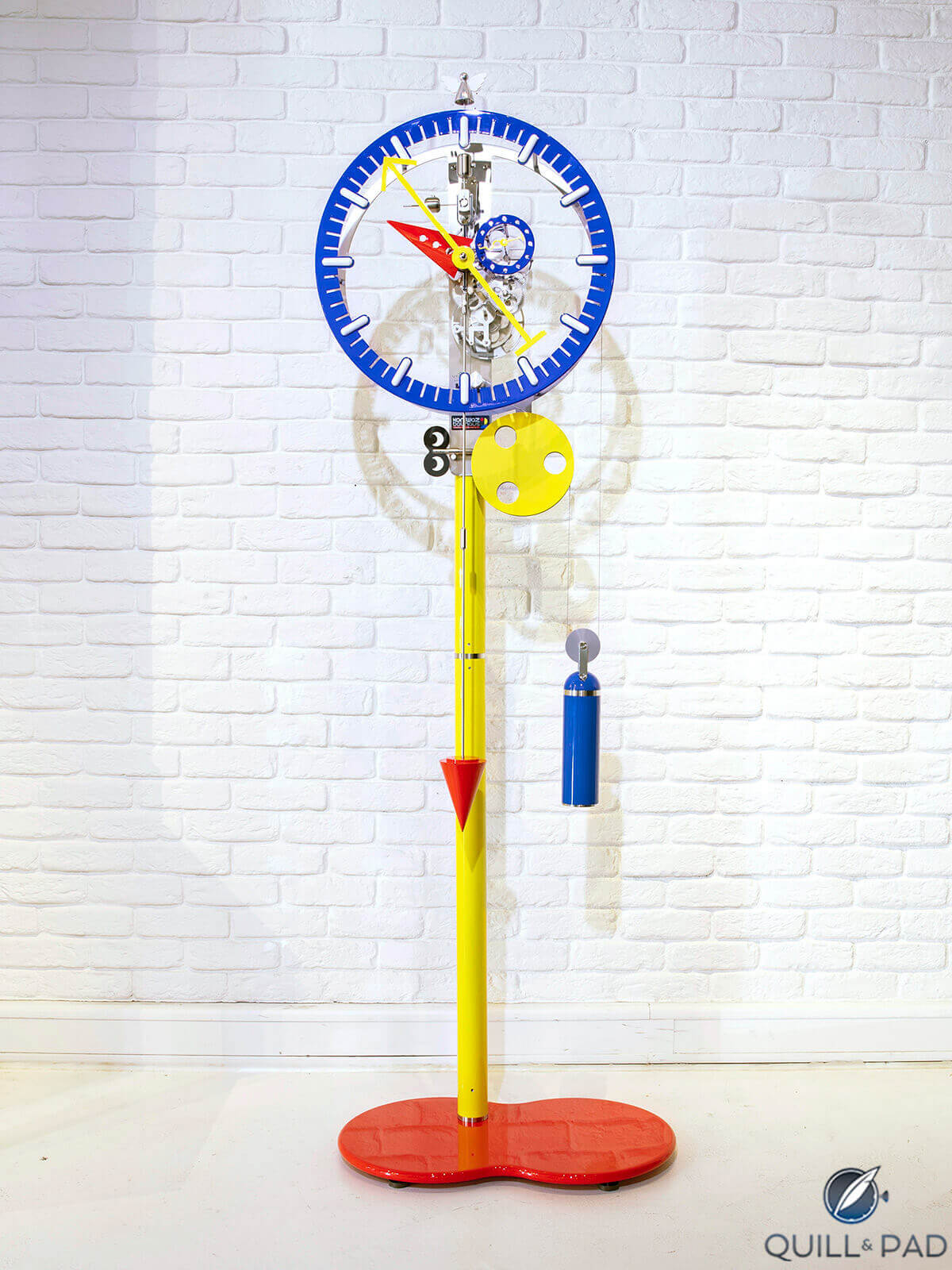
Alain Silberstein x Philippe Lebru KB2 Clock at the MB&F M.A.DGallery Geneva
JM: I already know that Elizabeth will likely be enamored by this since she has such a soft spot for Alain Silberstein, but I am the least enthusiastic about this piece in relation to the rest of the clocks in the group. I have never been hugely into the aesthetics of Silberstein’s colors and shapes, but I can admit that this is still a very cool clock. Without seeing it in person I can only judge based on photos and videos, but in the video reel it seems the finishing is not up to snuff, which could be a big problem for the jury. Since it is such a distinct style and design, and it may fall flat for horological skill and prowess in this group.
ED: Right you are, Joshua! If I had a place for it, I would probably want to buy this clock. There is nothing I don’t love about it.
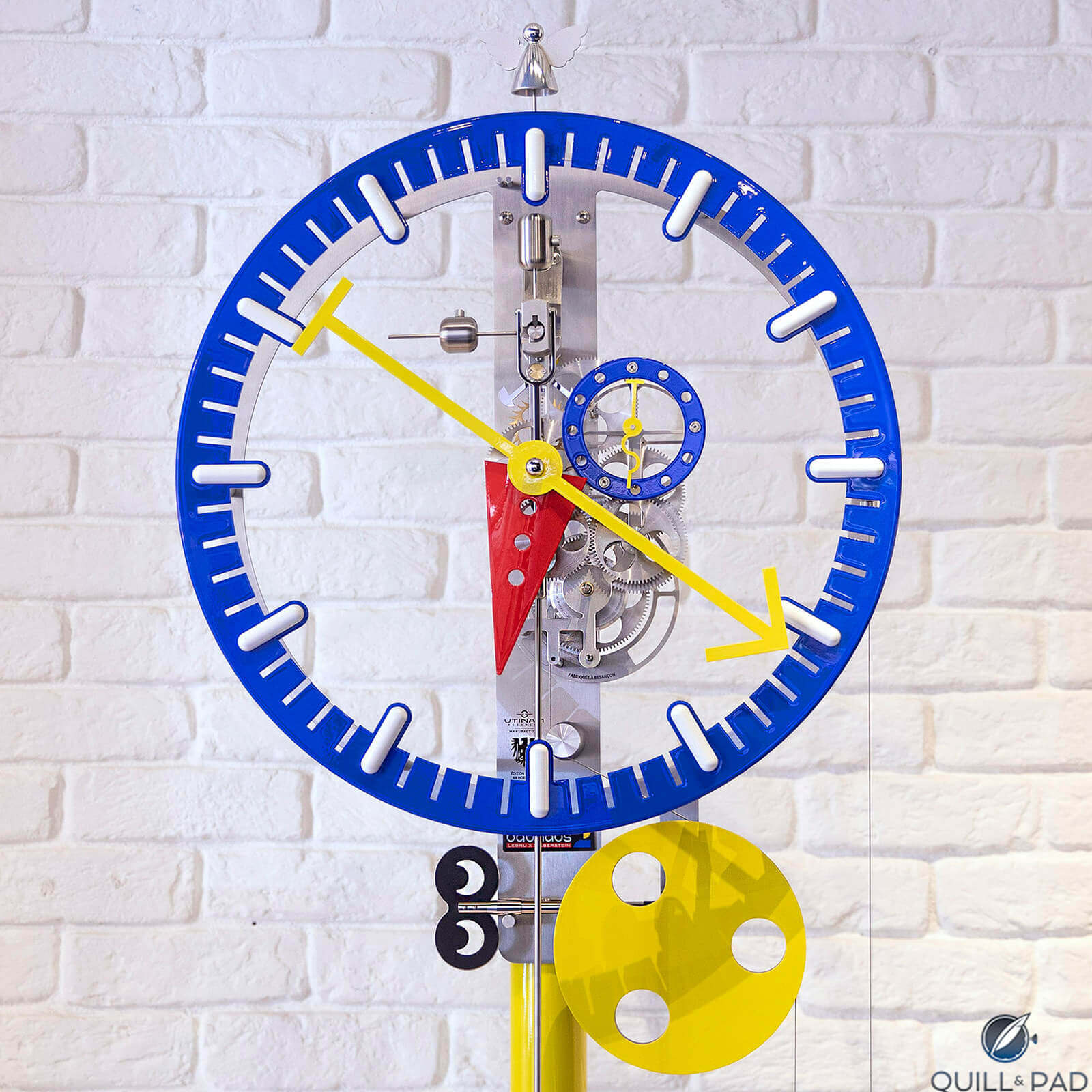
Alain Silberstein x Philippe Lebru KB2 Clock
GG: Perhaps the least complex of the entries is the one that I personally long to own: the Lebru X Silberstein KB2. I’m a huge fan of Silberstein’s Bauhaus-inspired visual style and would dearly love to have this big boy ticking away in my office, if only I didn’t fear that our cats would constantly be jumping up and batting the pendulum or winding weight around!
IS: For fans of Alain Silberstein (and who isn’t a fan of Alain Silberstein?), the Lebru x Silberstein KB2 is a perfect representation of his work. In fact, I think that Silberstein’s trademark primary colors (red, yellow, blue) and geometric shapes (circle, triangle, square) work much better on a large scale like a clock than in a wristwatch. This is a clock I’d love to have in my office; it would brighten up any room. I think that it’s too “simple” to win here, but I love the fact it’s a finalist.
Further reading: Alain Silberstein x Philippe Lebru KB2 Clock (Video)
Quick Facts Utinam Lebru x Silberstein KB2
Measurements: 25 cm x 53 cm x 131 cm (wall clock), 38.5 cm x 53 cm x 200 cm (tall clock)
Materials: stainless steel, brass, aluminum
Weight: 20 kg (wall clock), 50 kg (tall clock)
Movement: 0.5 Hz (one-second) pendulum clock with seven-day power reserve; 161 components; 3,600 vph/0.5 Hz frequency, weight 6 kg on steel cable
Functions: hours, minutes, seconds
Limitation: 88 pieces
Price: CHF 29,700
Van Cleef & Arpels Fontaine Aux Oiseaux
JM: This is the piece that not only doubles down on automata, but doubles down on decoration, finishing, and sheer display of mechanical creativity. Whereas every other piece was first and foremost about displaying the time, that is almost an afterthought for the Fontaine Aux Oiseaux Automaton. The flapping, chirping, fluttering birds that rotate on irregular patterns around the fountain, the dragonfly and lily pads that float over the rippling water, the lotus blossom opening while the dragonfly lifts off from the water; all of this stands front and center as the purpose of the Fontaine Aux Oiseaux.
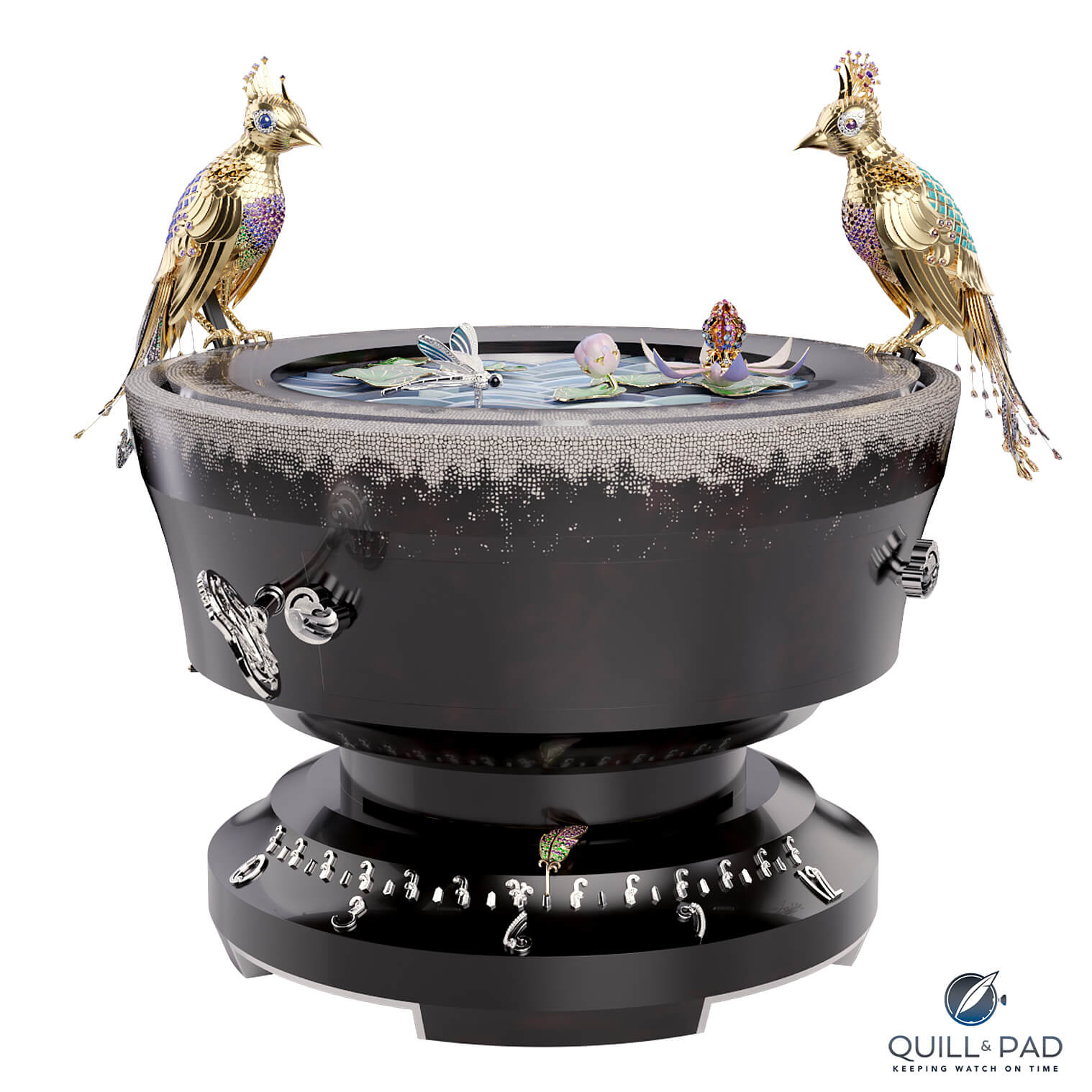
Van Cleef & Arpels Fontaine aux Oiseaux
The time is displayed with low accuracy having a 12-hour scale with marked half hours, with retrograde function to return the indicating jeweled feather back to zero to begin again. The dramatic use of gemstones, semi-precious stones, marquetry, enamel, and the famously difficult and gorgeous Urushi lacquer demonstrate that this piece is intended to be a museum piece or a centerpiece of an art collection. It is part of the Van Cleef & Arpels Extraordinary Objects collection and that seems fitting, it can be said to be nothing less than that. Since it is the least time focused piece in the group, that could have some detraction, but I don’t think the mechanical ingenuity and the craftsmanship on display can be discounted enough for it to take anything other than first place. I love Miki Eleta, and he deserves recognition for his piece, but Van Cleef have entered what could be a historical piece of art fit for a monarch, and I think it will capture the jury’s imagination the most to take the crown.
GG: How are you going to beat the Van Cleef & Arpels Fontaine Aux Oiseaux automaton? I watched the video of this marvel a good five times and will be returning to it again, I’m sure. The imagery is splendid, the aesthetics stunning, and the animation – down to the flexing talons of the birds softly touching down each time a bird moves – is nothing short of inspiring.
MG: I saw this clock in action at Watches and Wonders, and I am still in awe when I think about it. Even when it is not activated, it is already incredibly beautiful. But the sense of motion is so natural that you just want to watch it over and over again. It is almost like a theme park attraction yet made with such craftsmanship and artistic sense that it could be placed equally well in a museum. My winner in this category.
ED: I find it incredibly hard to bet against this work of art in this category and therefore predict it will take the crown here.
IS: The Van Cleef & Arpels Fontaine aux Oiseaux automaton should have been in the Mechanical Exception or Artistic Crafts categories as it is so much more than a clock. In Artistic Crafts it would impress with its stunning jewels, gem-setting, music, Urushi lacquer, enameling, lapidary, and automates.
I could easily see the Fontaine aux Oiseaux winning here because it just so impressive on (nearly) every level – and priced upwards of five million Swiss francs, it should be impressive – but this is the Clock category and should be judged on how superlative it is as a clock rather than a work of art. The Van Cleef & Arpels Fontaine aux Oiseaux automaton is my close runner up, but I can easily see the jury handing it the prize.
Further reading: Van Cleef & Arpels Fontaine Aux Oiseaux Automaton: A Magical Way To Pass Time
Quick Facts Van Cleef & Arpels Fontaine Aux Oiseaux
Basin: 411.3 x 441.5 mm, wood with Urushi lacquer and eggshell marquetry, natural scene with water, dragonfly, lilies and two birds made of gold, enamel, and various gemstones (185.25 ct) including colored sapphires, emeralds, tsavorite garnets, mandarin garnets, amethysts, diamonds, lapis lazuli, turquoise, chalcedony, and rock crystal
Movement: manual wind with eight-day power reserve, 18,000 vph/2.5 Hz frequency
Functions: retrograde hour and minute; automaton
Limitation: one unique piece
Price: CHF 5-10 million (exact price on request)
Predicted winners
Elizabeth: Van Cleef & Arpels Fontaine Aux Oiseaux
Joshua: Van Cleef & Arpels Fontaine Aux Oiseaux
Gary: Van Cleef & Arpels Fontaine Aux Oiseaux
Martin: Van Cleef & Arpels Fontaine Aux Oiseaux
Ian: Miki Eleta The Passage of Time
You may also enjoy:
GaryG’s Early Winning Picks For The Grand Prix d’Horlogerie De Genève (GPHG) 2022
Leave a Reply
Want to join the discussion?Feel free to contribute!





















































This one is easy: vc&a
Quick question.:i am wondering why the new atmos hybris mechanica is not there? Does it cost something for the competitors to join the competition? How are the competitors selected, if there are too many applicants in a category?
Hi, yes it does. This is clearly stated in the rules on the website: https://www.gphg.org/horlogerie/en/gphg-2022/rules
Thank ou for pointing me in the right direction. 5k CH for clocks would have made it really worth it for the atmos, in my humble opinion.
Mine too, but it’s not my opinion (or that of the Grand Prix d’Horlogerie de Genève) that you need to get this clock entered . . .
Dear Panelists, never before have I been more excited about a category and the nominated and participating clocks than about this 2022 category.
Finally there is a place for medium and large size timepieces, desk clocks, longcase clocks, table clocks. In my house they call them flatmates and treat them as part of the community. It’s almost impossible for me to decide on a winner here, but I suppose Miki Eleta (a pioneer and ambassador) and Van Cleef and Arpels have very high chances. But every timepiece here would have deserved it. All the very best, Thomas
A pity the most innovative/modern concept by Code 41 did not make the cut.
I wonder why the academy is not able to recognize/value future concepts?
best
Richard
Richard, thank to Élisabeth and the link to the rules of the competition you will see that there are deadlines and pieces need to be commercially available at a cut off date. The new code 41 would qualify next year I suppose. 700 FCH to enter, and 5000 FCH if nominated. And I would think that the code41 would easily be nominated in the “table” clock category.
Because the Academy is made up of more than 600 people of varying degrees of knowledge and tastes. It’s just the way a “democratized” style of judiciary works….
I also absolutely loved the concept from Code41 and adore the idea of a table clock that is small enough to be taken on the go, almost like a traveling alarm clock for the cyberpunk future! But I could also make the argument that the Konstantin Chaykin Lucomorye was more than worthy of being a finalist, as well as the Trilobe La Réciproque, so you can’t really have 9 finalists when categories are limited to 6 – there will always be disappointment. I’ll just try to be happy there is a clock category, and then we can start pushing to have a couple different clock categories to focus them more!